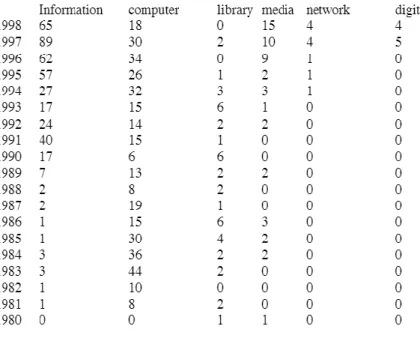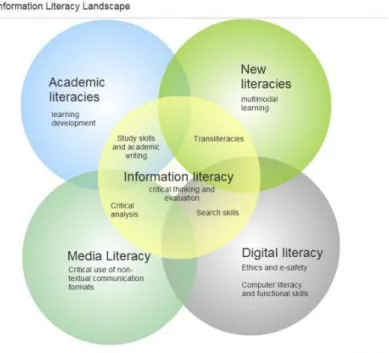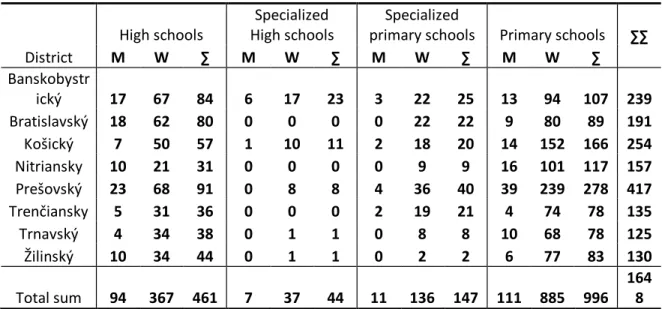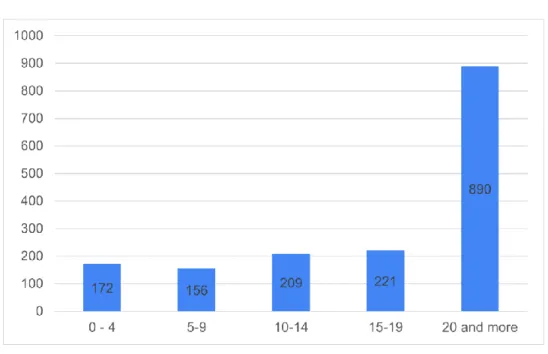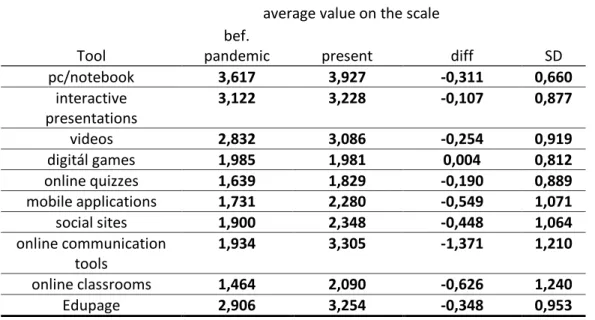69 https://doi.org/10.17048/AM.2020.69
Annamária Brijaková
Comenius University in Bratislava, Slovakia
annamaria.brijakova@uniba.ske
Information and digital literacy of teachers in Slovakia an their adap- tation on homeschooling
Abstract
The pandemic situation rapidly changed the way of education throughout the whole world.
Teachers had to adapt to the virtual environment and started to use new media which many of them did not know before. In Slovakia, for some of them, it was a new opportunity how to transform edu- cation into the 21st century, others saw it as a challenge for learning to use innovative methods and technologies but many teachers perceived this period as very de-manding. Differences have emerged not only between individual schools but primarily bet-ween teachers themselves.
The aim of our research during the closure of the schools was to map the situation regarding teacher education in information and digital literacy and their readiness to use technologies during a pandemic situation. The research was carried out using a questionnaire method with a total of 1670 participants. It was filled in by primary and secondary school teachers, inc-luding all types of schools (public, private, church and special).
1 Introduction
In the field of new literacy, a large amount of research has been carried out, especially in recent years. Many of them focus on the integration of modern technologies into the educational process and on the development of information literacy, which is essential for their effective use and life in modern society. How educational technologies and innovative methods of education are integrated into schools is also addressed by many educational initiatives, both nationally and internationally.
In the following article, we present the preliminary results of research on mapping information and digital literacy (IDL) of Slovak teachers. Since IDL is the basic starting point for education in the 21st century, based on normative documents such as "DigCompEdu – European Framework of Digital Competences for Educators" (Vuorikari et al., 2018), which ranks digital competences among the
70 basic pillars of modern education, in our research, we focused on the current state of IDL teachers in Slovak schools (it includes primary, secondary and upper secondary formal education). The im- portance of the topic is also underlined by the pandemic situation when schools were closed all over the world and online teaching was implemented.
2 Definitions and specific aspects of information literacy
A clear definition of the term information literacy (hereinafter IL) is problematic, as it includes re- latively complex meanings and attributes. Historically, its importance and rate of use have changed along with the development of information technology. In the 1970s and 1980s, the occurrence of this term was relatively rare, and related terms mostly appeared in library and information abstracts (Fig. 1). The nineties and the beginning of the new millennium brought, in addition to the increased use of the term information literacy in the professional literature, also new concepts of network and digital literacy.
Fig. 1 Overview of library and information science abstracts (Bawden, 2001)
At this point, it should be noted that IL is directly related to literacy as such. While a literate per- son can read, write, and understand his or her language according to the most general criteria, its meaning can be extended to "the ability to make effective use of information obtained from written materials" (Bawden, 2001). Literacy itself thus presupposes the ability of an individual to work with information.
Being information literate in the first stages of IL development meant, in particular, having the ability to search for information sources, which until then was primarily the role of librarians and
71 information specialists. Over time, IL has gone beyond library work and expanded to be used in the private and commercial sectors. According to Zurkowski (1974), IL should be a skill that every indivi- dual should have. This is stated also by Taylor (Taylor, 1986 in Bawden, 2001), who considers infor- mation literacy to be „an effective combination of the amount of knowledge and skills that every educated person will need to function effectively in an information-rich technology society".
The American Library Association published a report in 1989 defining IL in terms of the attributes that an information-literate person should meet. It is the ability to recognize when information is needed and the ability to find, evaluate, and effectively use that necessary information (American Library Association, 1989). This report subsequently created a national forum for information lite- racy, involving more than ninety national and international organizations.
Association of College and Research Libraries defines IL more complexly, as "the set of integrated abilities encompassing the reflective discovery of information, the understanding of how information is produced and valued, and the use of information in creating new knowledge and participating ethically in communities of learning". (Association of College and Research Libraries, 2016).
Information literacy in all its complexity includes several other levels. These include, for example, traditional literacy, the more commonly used term library literacy in the past, to current related terms such as computer literacy, media literacy, digital literacy, network/internet literacy, research skills and critical thinking. Newer approaches (JISC, 2015; Edith Cowan University, 2019; Park, 2019) include the above-mentioned literacy under one central concept, and that is "digital literacy". In Fig.
2 we can see the representation of information literacy to other literacies.
Fig. 2 Information Literacy Landscape (Hutchinson, 2017)
72 2.1 Dimensions of the Information Literacy
As indicated above, IL is perceived by the scientific community in different ways. Christine Bruce sets aside several dimensions that reflect the ambiguity of the concept itself. According to her, IL can be seen as the use of information and communication technologies and a combination of skills in their use; a way how to acquire mental models in the use of information systems; as the process itself; as a combination of skills, attitudes, and knowledge and thus their integration; as the ability to learn; or as a complex of ways of using information (Bruce, 2000). Thus, it can be said that IL gene- rally includes skills, attitudes, and knowledge in how to access, evaluate, and use information in dif- ferent contexts.
2.1.1 New Literacies
The term "new literacy" can be considered as a synthesizer of a wide range of differently focused emerging literacies related to technological progress typical of the 21st century. There are several definitions to help us understand what all new literacy includes. Guzzetti and Lesley (2016) refer to new literacy as "communicative practices associated with new digital media, often described as new mindsets." Similarly, Smith and Zygouris (2020) describe them as "new forms of literacy made possib- le by digital information and communications technologies (ICTs) and developments“. They also refer to the technological and cognitive processes that are utilized when using ICTs.
Kinzer et al. (2016) see parallels in working with non-digital text in the context of „new literacy" – the actual processing of text on the screen does not differ from that on paper but requires special knowledge of how to find, use and communicate text online using digital tools. According to him, new literacy is perceived differently by a person who was born with them, so to speak, and does not feel that he uses new skills and procedures in the field of literacy in his life than one who had to learn to use them later. As he goes on to say, the term „new literacy", although based on individual approaches, is used to describe how digital technologies are widely used and how these technologies have changed the lives of individuals and society as a whole.
Wilber (2012) discusses the notion that new literacy should be „ontologically and paradigmatically new." It brings the opportunity to do new things and thus establishes new rules of functioning in everyday life.
Finally, we will state the definition of Encyclopedia of Information Science and Technology closest to the definitions of information literacy, where Leu et al. (2008) describe new literacy as competen- cies in Internet skills to „identify important questions, locate information, critically evaluate the use-
73 fulness of that information, synthesize information to answer those questions, and then communica- te the answers to others”.
2.1.2 Relationship between information and digital literacy
Digital literacy (hereinafter DL) or digital information literacy was used in the 1990s in connection with the ability to read and understand hypertextual and multimedia texts. Lanham (1995) argues that literacy in itself in the digital age means the ability to understand information that is presented in any way. It emphasizes the multimedia nature of digital information. According to him, a digitally literate person has no problem using different types of media, is quick to adapt in their use, and can recognize a suitable type of media that is suitable for the presentation of specific information.
Gilster (1997) seeks to avoid a structured list of specific skills of the DL, and defines it as „the abi- lity to understand and use information in multiple formats from a wide variety of sources when it is presented via computers“. DL itself demands the use of digital technologies, so Gilster sees it „as literacy in the digital age".
Kalaš (2013) in his definition refers to DL as „the knowledge, skills, and understanding needed for the appropriate, safe and productive use of digital technologies".
There are a large number of definitions and approaches that address information and digital lite- racy. It is important to integrate them and at the same time reflect the latest trends. However, it can be said that many of the characteristics and skills of information and digital literate people overlap or complement each other, creating a holistic picture of the new literacy needed for the twenty-first century.
2.2 Education in the field of information literacy
The development of technology in each area and the enormous increase in information underli- nes the importance of educating and embedding IL in everyday practice. Educators as guides on the path to knowledge are a group who are required to know the use of new educational methods as well as technologies. Information and digital literacy is currently a key ability they should have to educate other literate members of society. The International Literacy Association (ILA) argues that students should have the right to:
• Teachers who use ICTs skillfully for teaching and learning effectively
• Peers who use ICTs responsibly and actively share effective strategies applied to a range of li- teracy purposes and settings
• A literacy curriculum that offers opportunities to collaboratively read, share, and create content with peers from around the world
74
• Literacy instruction that embeds critical and culturally sensitive thinking into print and digital literacy practices
• State reading and writing standards that include new literacies
• State reading and writing assessments that include new literacies
• School leaders and policymakers committed to advocating the use of ICTs for teaching and learning
• Equal access to ICTs for all classrooms and all students (Walker et al., 2009)
As information technology has become part of every area of life in recent decades, it is necessary to introduce information education not only for students but also for teachers. They should be the first to be able to use the power of information. They should lead their students to a creative approach to information, to finding the right answers, to the application and creation of relevant and sufficiently up-to-date information. As Fitzgerald (1999), says, the ability to properly evaluate infor- mation is an essential life skill and the basis for lifelong learning.
How to implement information education is described by a large number of models. One of them is the information literacy model – Seven Pillars of Information Skills developed by the Society of College, National and University Libraries (SCONUL), which defines basic skills, competencies, attitu- des, and behaviors in the development of information literacy in higher education and that:
- identifying the need for information,
- assessment of current knowledge and identification of gaps, - creating a strategy for localization of information and data, - finding and gaining access to information,
- review of the research process, comparison, and evaluation of information, - professional and ethical organization of information,
- application of acquired knowledge, presentation of results, synthesis of new and old information with the aim of acquisition and dissemination of new knowledge (SCONUL Working Group on Infor- mation Literacy, 2011).
2.3 Pandemic and school closures
The closure of schools around the world due to the growing pandemic has raised questions about how education can be transformed online in the twenty-first century, how effective this way of edu- cation is and whether schools and teachers are prepared to adapt to such changes. Although the Internet and communication technologies bring huge benefits and offer opportunities and ways of learning in the form of e-learning, not all schools can sufficiently reflect these changes and progress.
In response to this situation, PISA has issued a "Framework for Guiding the Education Response to
75 Covid-19", in which it seeks to identify the most important needs that should be addressed in natio- nal plans. It also examines countries' responses to the education crisis.
The United Nations Educational, Scientific, and Cultural Organization (UNESCO), together with the United Nations Children's Fund and the World Bank, have decided to gather information on the res- ponses of national schools to school closures. The questionnaire was intended for officials of the Ministries of Education responsible for school education and takes place in two rounds. The following graph shows the share of teachers at different levels of schools who used different forms of teaching during a pandemic (Graph 1).
Graph 1 Proportion of teachers using different teaching methods (United Nations, 2020)
3 Research
3.1 Aim of the research
The main goal of the research is to map the level of information and digital literacy of Slovak teachers from primary to upper secondary education, including all types of schools. At the same ti- me, IDL integrates several competencies, such as searching for relevant information sources, orienta- tion between information sources, or understanding the information obtained to effectively integra- te information and resources into teaching. This is preceded by the ability to formulate an informa- tion request and subsequent critical evaluation of the information found. It is also about working with digital technologies and their adequate use for education (and self-education) and the imple- mentation of teaching.
76 3.2 Methods
In our research, we used the method of a questionnaire, which teachers filled in from May to mid July 2020, when schools were closed and online teaching took place.
All questions were mandatory and included all types (closed, open, and semi-closed). The basic division of questions within the first round of the questionnaire was set into two parts: the state BEFORE the pandemic and DURING the pandemic.
In addition to the questionnaire, we would also like to conduct interviews with teachers in the coming months.
3.3 Sample
The research sample in the first round of the questionnaire consists of teachers of all levels and types of Slovak schools (omitting universities) in various districts. In Tab. 2 we can see the age distri- bution of respondents. The average age of all participating teachers is 46.41. The largest group, 54%, consists of teachers with more than 20 years of experience (Graph 2). In Tab. 1 we see the distribu- tion of respondents according to selected criteria. In terms of gender, 86% are women with 1,425 respondents, there are 223 men (13.6%), which roughly corresponds to the results of the OECD TALIS survey, which says that up to 82% of all teachers in Slovakia are women (NÚCEM, 2018).
Tab. 1 Distribution of respondents by region, type of school, and gender
High schools
Specialized High schools
Specialized
primary schools Primary schools ∑∑
District M W ∑ M W ∑ M W ∑ M W ∑
Banskobystr
ický 17 67 84 6 17 23 3 22 25 13 94 107 239
Bratislavský 18 62 80 0 0 0 0 22 22 9 80 89 191
Košický 7 50 57 1 10 11 2 18 20 14 152 166 254
Nitriansky 10 21 31 0 0 0 0 9 9 16 101 117 157
Prešovský 23 68 91 0 8 8 4 36 40 39 239 278 417
Trenčiansky 5 31 36 0 0 0 2 19 21 4 74 78 135
Trnavský 4 34 38 0 1 1 0 8 8 10 68 78 125
Žilinský 10 34 44 0 1 1 0 2 2 6 77 83 130
Total sum 94 367 461 7 37 44 11 136 147 111 885 996 164
8
77
Graph 2 Number of years of respondents' experience
Tab. 2 Age of respondents
N 1648
Average 46,41 Median 47,00 Std. deviation 9,95
Minimum 19
Maximum 73
3.4 Results
For this article, we decided to use statistical analysis to evaluate some of the responses to how teachers used technologies before and during the pandemic. The aim is to compare the level of use of different types of technologies, tools, and services that teachers use in education.
When evaluating the statistical significance of differences in the responses representing the scale, non-parametric pairwise tests, in particular, the McNemar test and the McNemar-Bowker test, will be preferred instead of the standard parametric Student's t-test and chi-square, which assume a normal distribution and continuous dependent variable.
78
Tab. 3 The difference between the use of different types of instruments before and during a pandemic
Tool
average value on the scale
SD bef.
pandemic present diff
pc/notebook 3,617 3,927 -0,311 0,660
interactive presentations
3,122 3,228 -0,107 0,877
videos 2,832 3,086 -0,254 0,919
digitál games 1,985 1,981 0,004 0,812
online quizzes 1,639 1,829 -0,190 0,889
mobile applications 1,731 2,280 -0,549 1,071
social sites 1,900 2,348 -0,448 1,064
online communication tools
1,934 3,305 -1,371 1,210
online classrooms 1,464 2,090 -0,626 1,240
Edupage 2,906 3,254 -0,348 0,953
Teachers rated the use of each type of tool on a scale of:
1. never 2. little/rarely 3. quite a lot/often 4. very often
The largest increase in the using of technologies was in the use of online communication tools, mobile applications, and online classrooms. However, an increase was observed everywhere except for digital games (Tab. 3). However, this is a lack of statistical analysis, if we compare the use of digi- tal games before and during the pandemic using the binomial McNemar test, a statistically significant increase is shown (Tab. 4).
Tab. 4 McNemar test comparing the use of digital games
present 1+2 3+4 Before 1+2 1000 176 pandemic 3+4 121 258
N 1555
Chi2 - McNema-
rov 9,818
asymp. sig. 0,002
79 Similarly statistically significant is the analysis using the McNemar-Bowker test, where a 2x2 matrix is not required (McNemar Bowker Chi2 = 63.040 at 6 degrees of freedom and a 5% asymptotic significance level of 0.000).
Graph 3 Additional learning how and where to search for information resources on the Internet
After school closure, teachers had to adapt to online teaching in a relatively short period. Many of them had no experience with this form of teaching before, but as can be seen in Graph 3, almost 80%
of respondents to the question whether they realized any education in how and where to look for information sources on the Internet gave a negative answer.
The question is therefore whether this is due to the fact that education on how to search for in- formation sources was not carried out or that teachers simply did not interest in it alternatively they did not consider it as important.
However, as can be seen in Graph 4, during the pandemic, teachers sought a relatively large amount of additional information resources.
80
Graph 4 Searching for additional resources for their own education
Graph 5 Providing education about using technologies by schools
Respondents were also asked to answer a question about providing education di-rectly from their school on how to use technology. We see that 73% of schools provided online education to their teachers immediately or shortly after the schools were closed (Graph 5).
81
Graph 6 Realization of other education how to use DT
Graph 6 shows that more than half of the teachers needed further training in how to use digital technologies which may indicate that teachers needed to be educated beyond what their school provided.
4 Conclusion
The preliminary analysis has already shown how the Covid-19 program has significantly influenced the teaching process and how it has significantly contributed to the increased use of ICT in the educa- tional process. The need for online education for schools was a major challenge, especially in the early days of the pandemic, which is preliminarily shown by teachers' responses to the evaluation of online teaching in our questionnaire. Although previous research has shown relatively good results in Slovakia in many respects of IDL, equipping schools with technology is the same as in developed countries, and teachers use technology in their teaching, it is uncertain whether they are using their potential sufficiently.
The aim of our research was to map the level of information and digital literacy of teachers in a broader context - to compare the situation before the pandemic with the situation during closed schools. Preliminary results show an increase in the use of different types of technology during online teaching. The questionnaire also shows an increased interest of teachers in education in the use of technology. On the other hand, it is possible to see a relatively small interest in education in the field of searching for information sources, even though their teachers searched for them to a relatively large extent.
82
Bibliography
American Library Association. (1989). Presidential Committee on Information Literacy: Final
Report (Washington, D.C.). American Library Association.
http://www.ala.org/acrl/publications/whitepapers/presidential
Association of College and Research Libraries. (2016). Framework for Information Literacy for Hig- her Education. Association of College and Research Libraries.
http://www.ala.org/acrl/standards/ilframework
Bawden, D. (2001). Information and digital literacies: A review of concepts. Journal of Documenta- tion, 57(2), 218–259.
https://doi.org/10.1108/EUM0000000007083
Bruce, C. (2000). Information literacy programs and research: An international review. The Austra- lian Library Journal, 49(3), 209–218.
https://doi.org/10.1080/00049670.2000.10755921
Edith Cowan University. (2019). Digital Literacy Framework.
https://www.ecu.edu.au/__data/assets/pdf_file/0006/833145/Digital-Literacy-Framework.pdf Fitzgerald, M. A. (1999). Evaluating Information: An Information Literacy Challenge. SLMR, 2.
https://web.archive.org/web/20100529090404/http://www.ala.org/ala/mgrps/divs/aasl/aaslpubsan djournals/slmrb/slmrcontents/volume21999/ALA_print_layout_1_202785_202785.cfm
Guzzetti, B., & Lesley, M. (Eds.). (2016). Handbook of Research on the Societal Impact of Digital Media: IGI Global.
https://doi.org/10.4018/978-1-4666-8310-5
Hutchinson, E. (2017). Navigating the information landscape through collaboration. Connections, 101(2). https://www.scisdata.com/media/1484/connections101.pdf
JISC. (2015). Developing students’ digital literacy. Jisc. https://www.jisc.ac.uk/guides/developing- students-digital-literacy
Kalaš, I. (2013). Premeny školy v digitálnom veku. Slovenské pedagogické nakladateľstvo - Mladé letá.
Kinzer, C. K., & Leu, D. J. (2016). New literacies, New Literacies. In M. A. Peters (Ed.), Encyclopedia of Educational Philosophy and Theory (pp. 1–7). Springer Singapore.
https://doi.org/10.1007/978-981-287-532-7_111-1
Lanham, R. (1995). Digital literacy. Scientific American, 273(3), 160–161.
https://doi.org/10.1038/scientificamerican1095-160
83 Leu, D. J., Kinzer, C., Coiro, J., & Cammack, D. W. (2008). Toward a Theory of New Literacies Emer- ging From the Internet and Other Information and Communication Technologies.
https://doi.org/10.1598/0872075028.54
NÚCEM. (2018). Slovensko sa už po tretíkrát zapojilo do medzinárodného výskumu OECD TALIS o vyučovaní a vzdelávaní. Najnovšie zistenia o slovenských učiteľoch v TALIS 2018.
https://www.nucem.sk/dl/4449/TALIS%202018%20tlacova%20sprava.pdf
Park, Y. (2019). DQ Global Standards Report 2019: Common Framework for Digital Literacy, Skills and Readiness. DQ Institute.
https://www.dqinstitute.org/wp-content/uploads/2019/03/DQGlobalStandardsReport2019.pdf Pool, C. R. (1997). A New Digital Literacy: A Conversation with Paul Gilster. Educational Le- adership, 55(3), 6–11.
http://www.ascd.org/publications/educational-leadership/nov97/vol55/num03/A-New-Digital- Literacy@-A-Conversation-with-Paul-Gilster.aspx
SCONUL Working Group on Information Literacy. (2011). The SCONUL Seven Pillars of Information
Literacy: Core Model For Higher Education. SCONUL.
https://www.sconul.ac.uk/sites/default/files/documents/coremodel.pdf
Smith, H. L., & Zygouris-Coe, V. I. (2020). Theoretical and Practical Concerns Regarding Digital Texts in Literacy Instruction. In P. M. Sullivan, J. L. Lantz, & B. A. Sullivan, Handbook of Research on Integrating Digital Technology With Literacy Pedagogies: (p. 25). IGI Global.
https://doi.org/10.4018/978-1-7998-0246-4
Taylor, R. S. (1986). Value Added Processes in Information Systems. Greenwood Publishing Group Inc.
United Nations. (2020). Survey On National Education Responses To COVID-19 School Closures.
https://www.un.org/development/desa/dspd/wp-
content/uploads/sites/22/2020/08/sg_policy_brief_covid-19_and_education_august_2020.pdf Walker, B. J., Au, K., Edwards, P. A., & Mullen, M. (2009). New Literacies and 21st-Century Techno- logies. International literacy association. https://www.literacyworldwide.org/docs/default- source/where-we-stand/new-literacies-21st-century-position-statement.pdf?sfvrsn=6
Wilber, D. (2012). Trying to Get Ahead of the Curve: Raising and Understanding Current Themes in New Literacies Practices. The Educational Forum, 76(4), 406–411.
https://doi.org/10.1080/00131725.2012.709415
Zurkowski, P. G. (1974). The Information Service Environment Relationships and Priorities. Natio- nal Commission on Libraries and Information Science. https://files.eric.ed.gov/fulltext/ED100391.pdf
